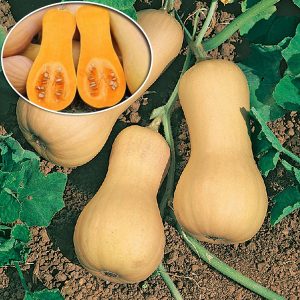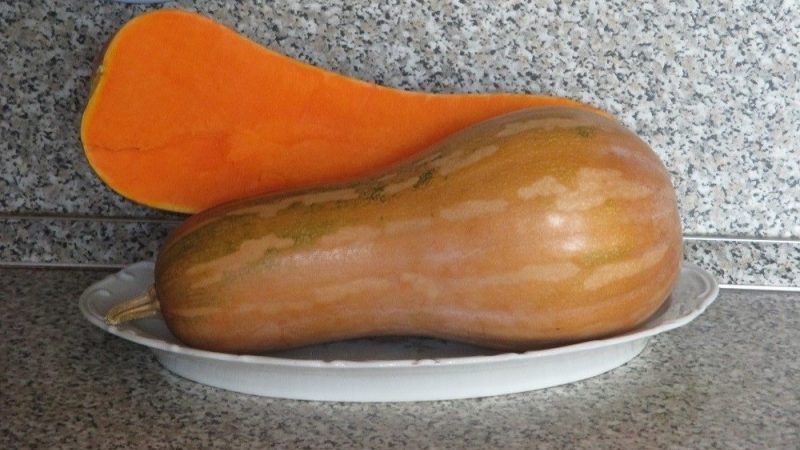We grow on our site a mid-season pumpkin "Guitar" with large fruits for long-term storage
Pumpkin is a useful melon crop. It is used in soups, main courses and even desserts. The Guitar variety of butternut pumpkin is popular with many gardeners. Excellent taste and the possibility of long-term storage make it attractive for gardeners. In 2013, the pumpkin of this nutmeg variety was entered into the State Register.
The content of the article
Description of pumpkin variety
The Spanish pumpkin is a medium-ripening variety. The crop can be harvested in 110-120 days. Pumpkin is an annual plant with an extended root system that is capable of feeding large fruits. The taproot reaches a length of 240 cm.
Reference! The plant clings to the supports with the help of antennae, which are located on the liana.
The stem of the pumpkin, which spreads over the site, has many soft hairs on the surface. It grows quickly and can reach 3-4.5 m. The leaves of the culture are five-lobed and are located on long spiny stems. Color - dark green with whitish spots. The yellow-orange pumpkin flowers are large, about 10 cm in diameter.

Distinctive features
The guitar belongs to the nutmeg varieties, therefore it has a characteristic spice aroma. Pumpkin tastes like carrots with an apricot aftertaste. The shape resembles a giant pear or guitar, which is why it is called that. The pulp contains plant fiber, vitamins and trace elements.
Fruit characteristics
The fruits are large and elongated, 70-80 cm long. Pumpkins reach a diameter of 12-15 cm in the narrowed part and 19-26 cm where the seeds are located. A thin and smooth rind covers the bright orange flesh, which occupies 90-95% of the fruit. One pumpkin can weigh from 2 to 6 kg.
The flesh of the pumpkin is dense and firm, when cut, it emits droplets juice... The vegetable is sweet, crunchy, easy to cut. It is eaten raw and cooked. During heat treatment, the taste is revealed brighter, becomes more fragrant.
Reference! Tasters' assessment - 4.9 points on a five-point scale of taste.
Yield
The variety is high-yielding, with excellent keeping quality of the product up to 100 days. The average yield is 2.7-3.6 kg per 1 m² of crops. Thermophilicity of the variety provides maximum yield when grown in areas with hot climates.
How to grow
Guitar pumpkin grow seedling method. However, in regions with a favorable climate, pumpkin can be grown by immediately planting seeds in the ground.
Planting a plant
Pumpkin seeds begin to be planted in April. Before planting, they must be sorted out and disinfected. It is not necessary to process purchased seeds: information on the preventive measures taken can be found on the package.
Self-collected seeds from the previous harvest are treated with a solution of potassium permanganate and water. Then the seeds are placed in a damp cloth for several days to sprout. Sprouted seeds are placed in small pots filled with peat.
Reference! To increase the germination of the plant, the planting material can be treated with wood ash. The ash is poured into hot water and the seeds are immersed there for several hours.
After germination, the strongest sprout is selected, the weak ones are removed.Containers with seedlings are left on the south side, since the plant loves warmth and light. To prevent the soil from drying out under the rays of the sun, it is often moistened with water at room temperature.
After 3-4 weeks, the seedlings are planted in holes, abundantly watered with water. The plant is placed in rows; gaps of 1.3 m are left between the rows, and at least 90 cm between the shoots. After planting, the soil is tamped and, if necessary, covered with agrofibre.
Seed planting is carried out in the southern regions. Disinfected and germinated seeds are immersed in holes to a depth of 5-10 cm. 2-3 seeds are placed in one hole at once. Plants are watered and covered if necessary. After the sprouts appear, they are thinned out, leaving the strongest.
Plant care
Pumpkin variety is unpretentious in care... However, dense foliage needs thinning... And after the formation of 2-3 ovaries on the stems, the pumpkin is pinched so that the plant is not overloaded and receives nutrition in full. Side shoots are also cut off so that the fruits have time to ripen.
16-22 days after planting seedlings carry out top dressing. The second time fertilization is applied during the period when the ovaries are formed.
Reference! From organic fertilizers, poultry manure, mullein, herbal infusions or a complex set of fertilizers for vegetables are chosen. Around the root, the pumpkin is sprinkled with wood ash.
Watering the pumpkin is exclusively soil-based. Water should not get on the leaves, this can lead to the formation of fungal diseases. When grown in greenhouses, pumpkin is watered 2 times a week with warm, settled water. Outdoors the plant has enough natural precipitation. After irrigation, the land must be loosened to provide oxygen and kill weeds.
Features of cultivation and possible difficulties

Culture loves warmth and sunshine. Therefore, when planting sprouts in open ground, the weather should be warm, without the risk of repeated frosts. When transplanted into the ground, the plant must have at least 3 grown leaves.
When looking for containers for pre-sowing, it is necessary to choose spacious and deep containers so that the pumpkin root system does not experience discomfort. When transplanting, an earthen ball is taken carefully, since the pumpkin root is very delicate. Even with minimal destruction of the coma, the plant can die.
Growing tips from experienced gardeners
Experienced gardeners advise planting a pumpkin on light fertile sandy loam soils with the addition of humus. It is better to use a greenhouse made of polycarbonate, which allows sunlight to pass through. In this case, moderate watering and ventilation is recommended.
They are planted in open soils when the soil temperature reaches + 12 ° C. The soil is fertilized every fall so that when planting plants in spring, the soil is filled with the necessary nutrients.
Diseases and pests
With abundant summer rains and sharp changes in night and day temperatures, the plant is at risk of developing root rot and bacteriosis. For prevention, overgrown lashes are thinned out. If the plant is sick, it is necessary to remove the diseased parts, and after harvesting, collect and destroy the remains of the plants.
Periodically, the pumpkin can be attacked by a spider mite or melon aphid. Insects are fought by spraying insecticides and acaricides.
Reference! To prevent the appearance of a tick, plants are irrigated with infusion of onion or garlic husks.
Harvesting and application of the crop

Harvested in early autumn. The fruits are removed along with the tails, which protects the delicate skin from damage. The pumpkin is placed in a basement or other dark room until fully ripe. The longer a vegetable is stored, the better its taste becomes. During the ripening period, the surface of the pumpkin hardens, and the flesh becomes a rich orange color.
Reference! With the support of a low moisture level, the fruits are stored for 3-4 months.
The vegetable contains many vitamins, is used during the diet, removes harmful, toxic substances from the body. Pumpkin is cholesterol free and is used as a diuretic. Eating a vegetable strengthens the immune system and the cardiovascular system.
Advantages and disadvantages of the variety
Butternut pumpkin has many advantages:
- sweet, juicy pulp;
- large fruits with excellent presentation;
- possibility long-term storage;
- resistance to arid climate;
- strong immunity to diseases, subject to the rules of cultivation.
The variety has practically no flaws. However, when growing, keep in mind that the plant is not suited for outdoor growing in northern regions.
Other varieties of butternut squash
There are several varieties that belong to the butternut squash.
Pearl
The harvest ripens at 115-125 days. Small dark green leaves have light spots on the surface. The elongated shape of the fruit resembles a matryoshka doll. The rind is bright orange in color, smooth to the touch. Fruit weight is 4 kg with a length of 50 cm.
The dark orange flesh is juicy and sweet in taste. The value of the variety lies in the high content of carotene. Pumpkin is used in cooking for a variety of dishes.
Vitamin
Pumpkin late ripening, the harvest appears on days 125-130. From 1 m² you can harvest 4 kg of pumpkin. The plant has green pentagonal leaves, on which small gray spots can be seen.
The fruits are oval in shape and have a segmented surface. The fruits reach a weight of 7 kg. The skin is brownish brown with a distinct green mesh. The bright orange flesh is thick and sweet in taste.
Farmers reviews

Gardeners who have ever cultivated the Guitar variety argue that even with a minimal investment of funds and effort, it is easy to get an excellent harvest.
Svetlana, Kostroma: “The pumpkin grows in a slightly different shape, not the one in the photo. I keep the pumpkins fresh for a long time in the cellar at home, in winter I cook porridge with pumpkin - the taste is honey, the children eat with pleasure. "
Irina, Uglich: “Pumpkin Guitar does not require watering, sometimes I don’t appear in the garden for a week, it feels great. We don't eat pumpkin ourselves, but the sweet pulp makes an excellent vitamin nutrition for our grandchildren. "
Conclusion
A bright representative of the nutmeg varieties, Guitar has no flaws in taste and is unpretentious in care. A large amount of sunlight and maintaining the temperature and humidity regime will provide gardeners with a bountiful harvest and a supply of vitamins for the whole winter.